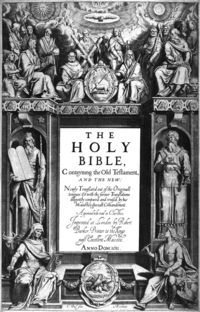Second Oxford Company
| King James Version | |
|---|---|

The title page to the 1611 first edition of the Authorized Version of the Bible by Cornelis Boel shows the Apostles Peter and Paul seated centrally above the central text, which is flanked by Moses and Aaron. In the four corners sit Matthew, Mark, Luke and John, authors of the four gospels, with their symbolic animals. The rest of the Apostles (with Judas facing away) stand around Peter and Paul. At the very top is the Tetragrammaton "יְהֹוָה" written with Hebrew diacritics.
|
|
| Abbreviation | KJV, KJB, or AV |
| Complete Bible published |
1611 |
| Online as | at |
| Textual basis |
OT: Masoretic Text, some LXX and Vulgate influence. NT: Textus Receptus, similar to the Byzantine text-type; some readings derived from the Vulgate. Apocrypha: Greek Septuagint and Latin Vulgate. |
| Reading level | US and Canada Grade 8–10 |
| Copyright | Public domain due to age, publication restrictions in the United Kingdom (See Copyright status) |
|
In the beginning God created the heaven and the earth. And the earth was without form, and void; and darkness was upon the face of the deep. And the Spirit of God moved upon the face of the waters. And God said, Let there be light: and there was light.
For God so loved the world, that he gave his only begotten Son, that whosoever believeth in him should not perish, but have everlasting life.
|
|
The King James Version (KJV), also known as the King James Bible (KJB) or simply the Authorized Version (AV), is an English translation of the Christian Bible for the Church of England, begun in 1604 and completed in 1611. The books of the King James Version include the 39 books of the Old Testament, an intertestamental section containing 14 books of the Apocrypha (most of which correspond to books in the Vulgate Deuterocanon adhered to by Roman Catholics and Eastern Christians), and the 27 books of the New Testament.
It was first printed by the King's Printer Robert Barker and was the third translation into English approved by the English Church authorities. The first had been the Great Bible, commissioned in the reign of King Henry VIII (1539), and the second had been the Bishops' Bible of 1568. In January 1604, James VI and I convened the Hampton Court Conference, where a new English version was conceived in response to the problems of the earlier translations perceived by the Puritans, a faction of the Church of England. The translation is noted for its "majesty of style", and has been described as one of the most important books in English culture and a driving force in the shaping of the English-speaking world.
...
Wikipedia
